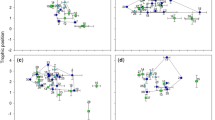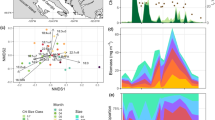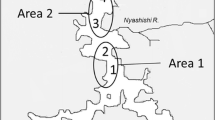Abstract
13C undergoes modes biomagnification in the food web, apparently as a result of being respired at a slower specific rate than12C. The degree of13C enrichment at each “trophic level” is related to the fraction of assimilated carbon which is respired. Qualitative and semi-quantitative aspects of ecosystem carbon cycling can therefore be deduced from13C enrichments, provided that isotope enrichments arising from other causes are accounted for. Most important among these is lipid storage, which enriches animals in12C. This complication can be handled in various ways, here it was done by “normalizing”13C:12C ratios to a constant lipid content. Remaining variations in13C:12C ratio presumably result mainly from respiratory isotope fractionation. The Bering Sea ecosystem provided a test for this procedure. Our results illustrate certain aspects of food web structure and suggest varous functional aspects.
Similar content being viewed by others
Literature Cited
Degens, E.T., G. Gotthardt and E. Reppmann: Metabolic fractionation of carbon isotopes in marine plankton — II. Data on samples collected off the coasts of Peru and Ecuador. Deep-Sea Res.15, 11–20 (1968)
DeNiro, M.J. and S. Epstein: Influence of diet on the distribution of carbon isotopes in animals. Geochim. cosmochim. Acta42, 495–506 (1978)
Eadie, B.J.: Distribution and fractionation of stable carbon isotopes in the Antarctic ecosystem, 110 pp. Ph.D. dissertation, Texas A&M University, College Station 1972
— and L.M. Jeffrey:13C analysis of oceanic particulate organic matter. Mar. Chem.1, 199–209 (1973)
Fry, B.D.: Stable carbon isotope ratios — a tool for tracing food webs, 126 pp. M.A. thesis, University of Texas, Austin 1977
Haines, E.B.: Relation between the stable carbon isotope composition of fiddler crabs, plants, and soils in a salt marsh. Limnol. Oceanogr.21, 880–882 (1976)
Isaacs, J.D.: Unstructured marine food webs and “pollutant analogues”. Fish. Bull. U.S.70, 1053–1059 (1972)
— Potential trophic biomasses and trace-substance concentrations in unstructured marine food-webs. Mar. Biol.22, 97–104 (1973)
McConnaughey, T.: Ecosystems naturally labeled with carbon-13: applications to the study of consumer food webs, 127 pp. M.S. thesis, University of Alaska, Fairbanks 1978
Mosora, F., M. Lacroix et J. Duchesne: Variations isotopiques13C/12C du CO2 respiratoire chez le rat, sous l'action d'hormones. C. r. hebd. Séanc. Acad. Sci., Paris273, 1752–1753 (1971)
Parker, P.L., E.W. Behrens, J.A. Calder and D. Shultz: Stable carbon isotope ratio variations in the organic carbon from the Gulf of Mexico sediments. Contr. mar. Sci. Univ. Tex.16, 139–147 (1972)
Rafter, T.A.: The dating of fossil man in Australia.In: Proceedings of Symposium on Hydrogeochemistry and Biogeochemistry. Vol. 1: Hydrogeochemistry, pp 306–336. Ed. by E. Ingerson. Washington, D.C.: Clarke Co. 1973
Sackett, W.M., W.R. Eckelmann, M.L. Bender and A.W.H. Bé: Temperature dependence of carbon isotope composition in marine plankton and sediments. Sciences, N.Y.148, 235–237 (1965)
Williams, P.M. and L.I. Gordon: Carbon-13: carbon-12 ratios in dissolved and particulate matter in the sea. Deep-Sea Res.17, 19–27 (1970)
Author information
Authors and Affiliations
Additional information
Communicated by N.D. Holland, La Jolla
Publication No. 380 of the Institute of Marine Science, University of Alaska
Rights and permissions
About this article
Cite this article
McConnaughey, T., McRoy, C.P. Food-Web structure and the fractionation of Carbon isotopes in the bering sea. Mar. Biol. 53, 257–262 (1979). https://doi.org/10.1007/BF00952434
Accepted:
Issue Date:
DOI: https://doi.org/10.1007/BF00952434




